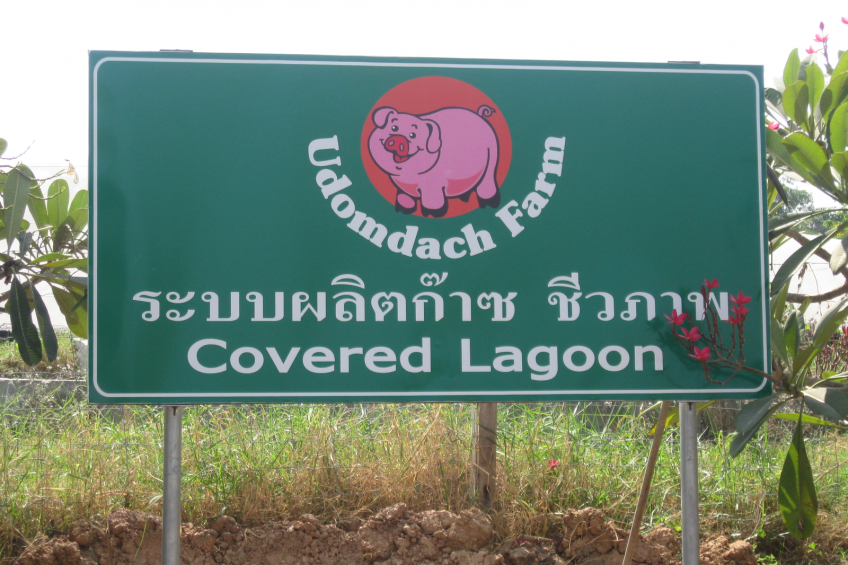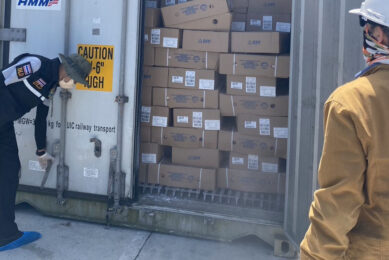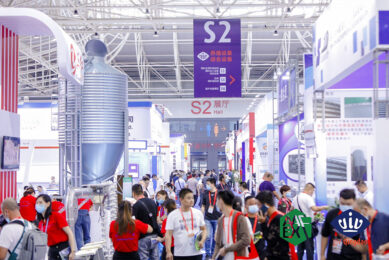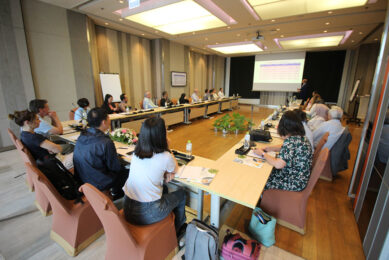Focus on Thailand: the first biogas pig farm

Very shortly, the agricultural world will turn its eyes to Thailand, when the capital, Bangkok hosts the ninth edition of VIV Asia.Pig Progresstravelled to Thailand to uncover developments ongoing in South East Asia – and visited the pig farm with the first-ever commercially successful biogas installation in the land of smiles.
By Vincent ter Beek
The first impression of Udomdach Farm is that of a colourful painting. Alongside a long, wide, well-kept lane, green palm trees on either side hide yellow feed silos under a vast blue sky. The painting, however, comes with a familiar smell – giving away the fact that the inhabitants of this painting are very close by. There are about 35,000 of them at this finisher farm, located near the town of Ratchaburi, at about 100 km west of Thailand’s capital, Bangkok.
Udomdach Farm details:
Number of finishers: 35,000
Origin of the piglets: five surrounding farms – no contracts
Weight piglets upon entrance: 17-21 kg
Weight pigs at slaughter: 106-110 kg (dead weight); 120 kg (liveweight)
Sold to: Superstore Tesco Lotus
Vaccination: Foot-and-Mouth Disease, PRRS, Classical Swine Fever
Disease pressure: PRRS, PRDC, Mycoplasma, some ileitis
Mortality: 4-6%
Feed Conversion Rate: 2.3-2.6
Average time of stay: 120 days
Employees: 100
Introducing itself as ‘one of the most successful farms in Ratchaburi province’, the farm started off with a small rice field, having rice bran as a by-product, which later became used as pig feed.
Udomdach Farm was set up by Dang Theerasatayakul and his wife Suvadee Theerasatayakul, over 30 years ago. At the moment, farm management is in the capable hands of their son Udomdach Theerasatayakul, who graduated and entered the farm about two years ago. The farm presents itself as a facility based on three management principles:
•SBltFarm management: in the past the farm suffered from several diseases, resulting in high production costs. For that reason, the farm joined the standardised farm programme of the Department of Livestock Development (DLD). “DLD officers gave some advice about farm management, selection criteria for choosing pig replacements and selling strategies to consumers,” explains Dr Yukol Limlamthong, DLD representative.
•Nutrition and feed management: much attention is paid to feed management, explains Dr Winai Thongmak, as all raw materials are specifically chosen. Attention is paid to lysine, calcium and phosphorus levels and palatability of the dry finisher feed is enhanced by oils. A strict health programme for incoming pigs is followed to ensure a good health status; no antibiotic growth promoters are being used.
Environmental management
The third focus of the farm is related to improving the environment. “As Udomdach Farm would like to improve the farm’s environment and develop alternative energy, the biogas concept was introduced,” explains Udomsak Lochachipitaks, energy and environment department manager at the farm.
The biogas facility was the first commercially successful one on a farm in Thailand, says Angel Rodriguez Paz, representing Jiamphattana Energy International, the company that imported the biogas installation from the Spanish manufacturer, Guascor. In total, his company now supplies about 80 farms throughout Thailand, since it started representing the manufacturer in 2005.
Initially, one small biogas transformator was installed, Rodriguez Paz explains, which generated a power of 450 kWatt on the basis of biogas. Shortly afterwards, a larger one was added to that generating 800 kWatt. There are already plans for building a third later this year, also generating 800 kWatt.
Altogether, the 35,000 animals now ‘yield’ slurry for about 1,200 m3/day. The plan is to increase this amount to 2,000 m3/day, by buying more slurry from farmers in the neighbourhood. Slush is then taken out by the use of gravity. The total amount is stored in three covered lagoons on-site of 10,000 m2(50 x 200), 4,000 m2(40 x 100) and 6,300 m2(45 x 140).Under cover, the solid slurry is being processed through natural processes until a gas comes into existence consisting of about 63-66% methane. This is taken to the biogas transformators which converts it into energy. The energy is subsequently being used on-farm and the rest is sold to the Provincial Electric Authority – something which is generally applauded since a continuous flow of energy is guaranteed with so many pigs. With a sophisticated farm set up like it is today – and with both expansions on-farm and a greater pivotal role for treating slurry from the wide surroundings, the question remains – will Udomdach Farm remain predominantly a pig farm or will it become an energy company, selling pigs as a ‘by-product’? Farm manager Udomdach Theerasatayakul simply smiles. “Of course – it will always be a pig farm first.”
[Source: Pig Progress magazine Vol 25 nr 1, 2009]
Join 18,000+ subscribers
Subscribe to our newsletter to stay updated about all the need-to-know content in the pigsector, three times a week. Beheer
Beheer










 WP Admin
WP Admin  Bewerk bericht
Bewerk bericht